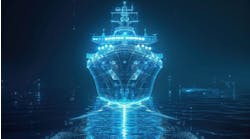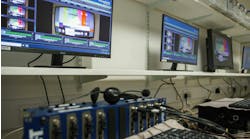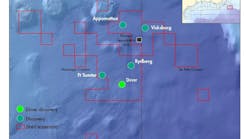Gene Kliewer - Houston
Gjøa goes electric
StatoilHydro plans to make the Gjøa platform, expected onstream in 2010, the first floating production platform in the North Sea to get electricity from shore. A cable from a new power plant at Mongstad, north of Bergen, will supply the power. StatoilHydro says the goal of the move is to reduce carbon dioxide emissions.
“With the electrification of the Troll A platform and Kollsnes, and the decision to electrify Gjøa, StatoilHydro is a front-runner with a view to reducing emissions of nitrogen oxides and carbon dioxide,” says Trude Sundset, VP for environment and climate.
Gjøa and the Vega satellite represent the largest North Sea project under development today with investment of NOK 37 billion ($6.5 billion).
Gjøa is being developed with a semisubmersible production platform and five subsea templates. Gjøa’s recoverable reserves are some 82 MMbbl of oil and condensate, and 40 bcm (1.4 tcf) of gas. Vega’s recoverable reserves are estimated at 26 MMbbl of condensate and 18 bcm (636 bcf) of gas.
Gjøa partners are StatoilHydro (development operator - 20%), Gaz de France Suez (production operator - 30%), Petoro (30%), Shell (12%), and RWE Dea (8%).
First ‘all-electric’ gas from K5F
On the topic of subsea electrical power, Total has first production from K5F on the Dutch continental shelf. K5F is the first ever project to use all electric subsea equipment activation.
The development includes two subsea wells and a 10-km (6.2-mi) long, 20-cm (7 7/8-in) diameter subsea pipeline connected to the K6N satellite platform. After treatment, the gas goes onshore via the NoordGas Transport pipeline.
Total is the operator, with its partners E.B.N, Dyas BV, Goal Petroleum (Netherlands) BV, and Lundin Netherlands BV.
Mooring connector record set
First Subsea reports a new depth record of 8,637 ft (2,632 m) for ball and taper mooring connector application at Shell Oil Co.’s Perdido project in the Gulf of Mexico.
Nine “ballgrab” connectors were installed on the taut-leg chain/polyester rope/chain mooring lines to the truss spar. The connectors link the suction piles and ground chain segments.
Perdido is 200 mi (322 km) offshore at Alaminos Canyon block 857.
New CO2 pipeline standards in study
In another first, DNV and industry partners are working on a standard for moving CO2 via pipeline. DNV says current standards do not cover issues regarding dense, high-pressure CO2 applications. The point of departure will be existing pipeline standards, such as ISO 13623 and DNV OS-F101, for the transmission of hydrocarbons.
Project partners are StatoilHydro, BP, Shell, Petrobras, Vattenfall, Dong Energy, ArcelorMittal, Gassnova, Gassco, and ILF. The Technical Reference Group consists of government representatives from the UK, the Netherlands, and Norway. The European Commission also supports the initiative.
CSL gets first offshore Egypt project
Burullus Gas Co. has awarded CSL a contract for subsea operations support at Simian field, 114 km (71 mi) off Idku, Egypt.
The contract is valued at £750,000 ($1.37 million) and covers replacement of two glycol filtration units which prevent blockages in the pipelines that serve the Simian field’s subsea developments. CSL will provide engineering and construction support for the offshore phase of the project which is in 825 m (2,707 ft) of water and uses an ROV from Burullus’ subcontracted vessel, Saipem’sDP Reel.
Fugro, Devon investigate Brazilian deepwater metocean data
Devon Energy do Brasil Ltda, Fugro Brasil Ltd, and Fugro GEOS Inc. are investigating currents in deepwater 120 mi (193 km) offshore in block BM-BAR-03. The current data will support the derivation of design criteria for any future work.
The currents in the area are complex.
“The North Brazil Current (NBC) and its subsurface component, the North Brazil Undercurrent (NBUC), transport oceanic waters north westwards along the northern coast of Brazil,” says Rosemary Smith, senior oceanographer. “Once north of the equator, these currents feed a system of zonal counter currents which flow eastwards. Large, anti-cyclonic eddies (NBC rings) can form from the North Brazil Current and propagate northwards. They are thought to transport up to half of all the surface waters northwestwards. The NBC rings are of concern to drilling operations, as they are known to cause strong currents that can lead to down time during drilling operations.”
“To monitor these occurrences, a deepwater mooring with multi- oceanographic instrumentation has been deployed in 2,525 m (8,284 ft) of water,” says Paul Williams, operations manager.
Fugro GEOS already ran the ultra long mooring requirements through design software using a current profile based on existing data near BM-BAR-03. The analysis identified potential problems with mooring “knockdown” due to the impact of the currents on the mooring string.
An additional component to the study was a vessel mounted ADCP (VMADCP) currents survey and CTD profiles over the area. This survey, conducted following the mooring deployment, involved running survey lines using an ADCP to map the current features in real-time. These data provide spatial detail of the current features in the upper layer of the water column. A deepwater rated CTD collects full water column conductivity (salinity) and temperature profiles, providing information on the water column structure and the various water masses causing the circulation patterns.





